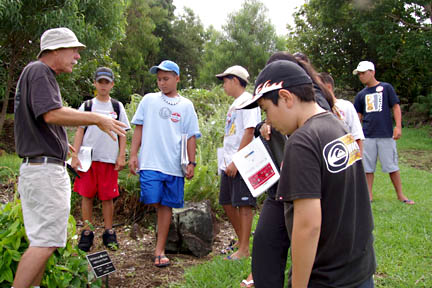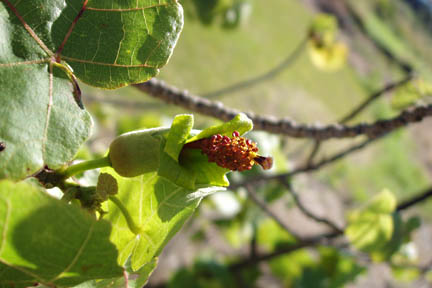
|
Hawaii’s
Back Yard |
Big Island garden a link
to Hawaii’s past
WALK through the Big Island's Amy B.H. Greenwell Ethnobotanical Garden with manager Peter Van Dyke and you'll feel like you're meeting beloved members of his family. He knows the names, special characteristics and stories behind each of the garden's 250 species of trees, shrubs and ferns, all thriving in Hawaii before Capt. James Cook's arrival in 1778."These plants are literally living history," says Van Dyke. "From them we can get a fascinating glimpse of the early Hawaiians' way of life -- the foods they ate, what they used to build their homes, the concoctions they made to treat illnesses and injuries, and the materials they used for adornments and religious purposes."
A branch of Bishop Museum that opened in 1988, the Amy Greenwell Garden meanders over 15 acres in Captain Cook, 1,500 feet above Kealakekua Bay on the slopes of the Big Island's Mauna Loa volcano. Its mission is to perpetuate Hawaiian cultural traditions that use plants and to conserve those plant resources.

Peter Van Dyke in the garden with students from Kamehameha Schools' summer program.
Upon her death in 1974, Greenwell bequeathed her property to Bishop Museum, specifying that it be planted with greenery in "the pre-Cookian style." Four zones of plant life used by Hawaiians before foreign contact are represented in the oasis that bears her name: coastal, lowland dry forest, upland forest, and food and fiber crops. Thriving in the agricultural zone are 60 varieties of taro, 34 varieties of sugar cane, nine varieties of awa (kava), 25 varieties of sweet potato and seven varieties of banana. These plants formed the basis of the ancient Hawaiians' diet and were used in many of their medicinal remedies.

Hau kuahiwi (Hibiscadelphus hualalaiensis) is being replanted from seeds from the last wild plant, which died.
Special events share isle gardening history and techniquesThe Amy B.H. Greenwell Ethnobotanical Garden welcomes the New Year with three special events:» The "Survey of Hawaiian Ethnobotany" series will be held 12:30 to 2 p.m. every Tuesday from Jan. 11 through Feb. 1. Students will learn traditional uses of native and introduced plants growing in Hawaii prior to Capt. Cook's arrival. Cost for four classes is $25. Call 947-7664. » The garden will host a taro workshop from 9 a.m. to noon Jan. 14. Participants will learn to make cuttings, and plant and care for dry-land taro. The fee is $10, free for Bishop Museum Association members. Call 808-323-3318. » The garden's first Grow Hawaiian Horti/Cultural Festival is set for 9 a.m. to 2:30 p.m. Feb. 26. It will feature live music, storytelling, plant sales, grafting demonstrations, a farmers' market and presentations by landscapers, conservationists, entomologists and other garden professionals. Home gardeners bring their ailing plants to receive a diagnosis and treatment plan from botanists and horticulture experts. Conservation groups will man information tables, and there will be displays of traditional Hawaiian arts such as kapa stamping, cordage making, pahu (drum) making and lau hala weaving. Admission is free.
|
Wahine noho kula (Isodendrion pyrifolium), a member of the violet family, was believed to be extinct from the late 19th century until 1991, when a sharp-eyed botanist spotted a patch of 50 plants on state land in Kona, adjacent to Kealakehe High School, that was being developed for residential housing and a golf course. Due to this development, as well as the influx of invasive species, only six of the original 50 plants remain.
"We're propagating wahine noho kula by seed in our nursery," says Van Dyke. "When they're ready in about nine months, we'll replant them in protected areas near the last remaining wild plants."
FOR ANOTHER conservation project, the Amy Greenwell Garden teamed up with the U.S. Fish and Wildlife Service and the Nature Conservancy to replenish the Big Island's population of a rare loulu palm species, Pritchardia schattaueri, which had dwindled to just 14 individuals in the wild. Says Van Dyke: "Nature Conservancy and Fish and Wildlife Service personnel collected seeds from those plants, and we propagated them. During the past few years, kids from the Hawaii Youth Conservation Corps have planted about 800 of our loulu seedlings in South Kona."
Van Dyke believes community involvement is key to the success of the garden's efforts; assuming stewardship of natural resources, committing to sustainable agricultural practices and exhibiting respect for native ecosystems are the responsibility of all.
"At the Amy Greenwell Garden, Hawaiian plants are grown as cultural treasures, carrying an important message from the past to the present to the future," he says. "Visitors to the garden learn about the place of plants in old Hawaii and how rare many of them have become. They leave inspired to protect these plants. In this way the plants can be preserved as precious cultural links for future generations."
If you go ...
What: Amy B.H. Greenwell Ethnobotanical GardenLocation: On Highway 11 just past Mile Marker 110 in Captain Cook, 12 miles south of Kailua-Kona
Hours: 8:30 a.m. to 5 p.m. weekdays
Tours: A self-guided tour along a quarter-mile loop trail through the center of the garden takes about 20 minutes. Reserve an hour to explore the entire garden. Three guided tours are also offered. On Wednesdays the focus is on "canoe plants" brought to Hawaii during the migrations of the first Polynesian voyagers, which began 1,500 years ago. Native Hawaiian medicinal plants are in the spotlight on Fridays. Both hour-long tours start at 1 p.m. Cost is $5, free for kids 11 and younger. A free 90-minute tour covering general information about the garden is available at 10 a.m. the second Saturday each month. Private tours for groups of five or more can be arranged.
Admission: For the self-guided tour, $4 for ages 12 and older; children 11 and younger are admitted free. All tours are free for Bishop Museum Association members.
Call: 808-323-3318
E-mail: pvandyke@bishopmuseum.org
Web site: www.bishopmuseum.org/greenwell
Also of interest: An archaeological remnant of the prehistoric Kona Field System is preserved on five acres of the garden. This land was part of a vast network of fields and farms that supported thousands of native Hawaiians 500 years ago. Remnants of farming activity are still evident, most notably in the form of eight kuaiwi, or low, long stone ridges running from the mountains to the sea that served as field boundaries.
[News] [Business] [Features] [Sports] [Editorial] [Do It Electric!]
[Classified Ads] [Search] [Subscribe] [Info] [Letter to Editor]
[Feedback]
